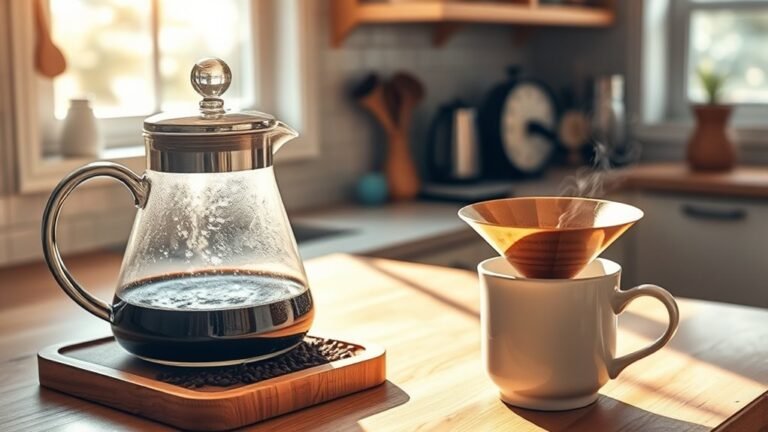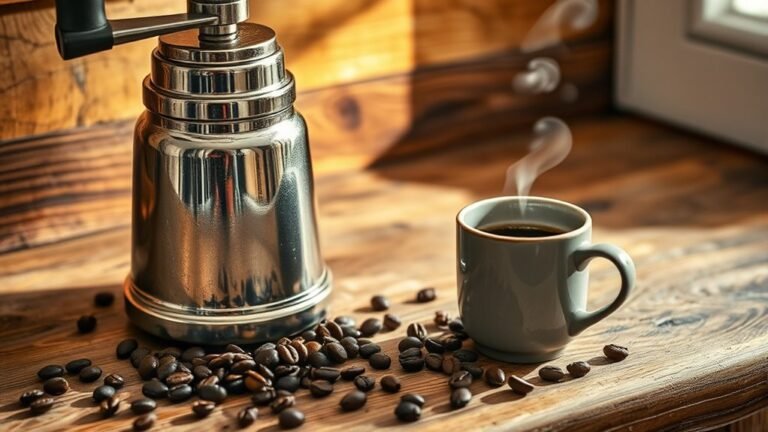How to Adjust Your Grind Size for a Better Brew
To adjust your grind size for a better brew, start by identifying your brewing method—espresso needs a fine grind, while French press calls for coarse. If your coffee tastes bitter or sour, try coarsening or fine-tuning the grind slightly. Watch your brew time; too fast or slow signals a grind tweak. Keep grind consistency and water temperature steady to isolate effects. Small changes can greatly improve flavor. Explore further to master the perfect balance and elevate your daily cup.
Understanding the Importance of Grind Size

Although it might seem like a small detail, grind size plays an essential role in how your coffee brews and tastes. When you control grind consistency, you’re directly influencing how evenly water extracts flavors from your coffee grounds. Inconsistent grind sizes lead to uneven extraction, which can make your brew taste off—either too bitter or too weak. Understanding this helps you gain freedom over brewing variables like water flow and contact time. By adjusting your grind size precisely, you can tailor your coffee to suit your preferences and brewing method. Whether you’re using a French press, drip, or espresso, getting the grind right guarantees a balanced and satisfying cup every time. Mastering grind size gives you the power to elevate your daily brewing experience.
How Grind Size Affects Coffee Flavor and Extraction
Your grind size directly influences the extraction rate, which shapes the balance of flavors in your cup. If your grind is too coarse or too fine, it can lead to under-extraction or over-extraction, altering bitterness and acidity. Matching your grind size to your brewing method guarantees you get the best flavor profile every time.
Extraction Rate Impact
Since grind size directly influences how quickly water extracts flavors from coffee grounds, it plays an essential role in determining the final taste of your brew. Understanding extraction variables helps you achieve ideal extraction for a balanced cup. Here’s how grind size impacts extraction rate:
- Finer Grind: Increases surface area, speeding up extraction but risks over-extraction, making your coffee bitter.
- Coarser Grind: Slows extraction, which can lead to under-extraction and a sour or weak brew.
- Consistency: Uniform grind size guarantees even extraction, avoiding bitterness or sourness caused by uneven extraction rates.
Flavor Profile Changes
Understanding how grind size affects extraction rate sets the stage for recognizing its impact on your coffee’s flavor profile. When you adjust grind size, you directly influence flavor intensity and aroma development. A finer grind increases surface area, speeding extraction and often intensifying bold, rich flavors, but it can also risk over-extraction, leading to bitterness. Conversely, a coarser grind slows extraction, which might highlight brighter, more delicate notes but risks under-extraction, resulting in weak or sour flavors. By mastering grind size, you gain control over balancing these elements, crafting a coffee that matches your taste preferences. This freedom to fine-tune means you can emphasize specific flavor characteristics and reveal the full aromatic potential of your beans with every brew.
Brewing Method Compatibility
Although grind size plays an essential role in flavor and extraction, its effectiveness largely depends on the brewing method you choose. Each method demands a specific grind size to release its full potential, making brewing method versatility key to your coffee freedom. When experimenting with grind size, consider these three main brewing methods:
- Espresso: Requires a fine grind to guarantee quick extraction and intense flavor.
- Pour-over: Benefits from a medium grind that balances flow rate and extraction.
- French press: Calls for a coarse grind to prevent over-extraction and bitterness.
Grind Size Recommendations for Different Brewing Methods
When you’re dialing in your grind for espresso, aim for a fine, almost powdery texture to guarantee proper extraction under pressure. For drip coffee, a medium grind strikes a balance that prevents over- or under-extraction, matching the typical brewing time. If you’re using a French press, go coarser to allow the grounds to steep fully without slipping through the filter.
Espresso Grind Settings
Since espresso demands a finely tuned grind, you’ll want to aim for a consistency that’s much finer than what you’d use for drip or French press. Your espresso machine relies heavily on precise grind consistency to extract rich flavors without bitterness. Here’s how to dial it in:
- Start with a fine grind resembling table salt—too coarse and the shot will be weak, too fine and it’ll taste burnt.
- Adjust your grinder in small increments, testing each pull to find the sweet spot where extraction is balanced.
- Keep your grind consistent; uneven particles cause channeling, ruining the shot’s quality and your freedom to enjoy perfect espresso anytime.
Mastering these settings means you control every shot and savor every sip exactly how you like it.
Drip Coffee Preferences
How do you choose the perfect grind size for your drip coffee? It depends on your drip coffee equipment and desired drip coffee ratios. A medium grind is most versatile, fitting most automatic drip machines and pour-over devices. Adjusting grind size fine-tunes extraction—coarser grinds speed flow, lighter taste; finer grinds slow flow, intensify flavor.
| Brewing Method | Recommended Grind Size |
|---|---|
| Automatic Drip | Medium |
| Pour-Over (V60) | Medium-Fine |
| Cold Brew Drip | Coarse |
Understanding your equipment’s flow rate and balancing it with grind size will help you find freedom in flavor control. Experiment within these guidelines to discover your perfect brew balance.
French Press Coarseness
Although grind size plays an essential role across all brewing methods, French Press demands a specific coarseness to extract the best flavor without bitterness or sediment. Getting it right reveals the full French press benefits—rich, bold coffee with a smooth finish. Here are key french press tips to guide your grind:
- Aim for a coarse, even grind—about the size of sea salt—to prevent over-extraction and clogging the mesh filter.
- Avoid fine grinds; they’ll slip through the press and make your brew gritty and bitter.
- Adjust your grinder until you achieve a chunky texture that allows water to flow freely and steep evenly.
Mastering this coarseness gives you freedom to enjoy a full-bodied cup without fuss.
Signs Your Grind Size Needs Adjustment

When your coffee tastes off or the brewing time feels unusual, it’s a clear sign that your grind size might need tweaking. If your brew is overly bitter or sour, it often indicates that the grind consistency is off—too fine or too coarse. Uneven grounds can lead to over-extraction or under-extraction, disrupting the brew balance you’re aiming for. Additionally, if your coffee takes much longer or shorter to brew than usual, that’s another clue. You might notice a weak or overly intense flavor, or sediment in your cup, which also points to grind size issues. Paying attention to these signs helps you regain control over your coffee’s flavor and texture, ensuring every cup reflects your free-spirited approach to brewing.
Tools and Techniques for Consistent Grinding
Choosing the right tools and mastering a few key techniques can make all the difference in achieving a consistent grind size. To guarantee grind consistency, focus on these essentials:
Master essential tools and techniques to consistently achieve the perfect grind size every time.
- Regular Grinder Calibration: Adjust your grinder settings gradually and test frequently. This keeps your grind size precise and tailored to your brew method.
- Use a Burr Grinder: Burr grinders provide uniform particle size, essential for consistency. Avoid blade grinders that produce uneven grinds.
- Weigh Your Coffee: Consistently measure your coffee dose before grinding. This ensures each brew starts with the same amount, improving repeatability.
Troubleshooting Common Grind Size Issues
Why does your coffee sometimes taste off despite careful grinding? The culprit often lies in inconsistent grind size. Uneven particles extract unevenly, leading to bitterness or sourness. To troubleshoot, first check your grinder for wear or clogging—both can disrupt grind consistency. Also, consider your brew temperature; even with perfect grinding, too high or low water temperature can throw off extraction balance. If your grind feels right but flavors are off, adjust your brew temperature slightly to find harmony. Remember, small tweaks in grind size or temperature can dramatically improve your cup. By focusing on these factors, you regain control over your brew’s flavor, freeing yourself from guesswork and enjoying a consistently satisfying coffee experience.
Tips for Experimenting With Grind Size to Perfect Your Brew

Although dialing in your grind size can feel like a trial-and-error process, having a clear approach will save you time and frustration. When you embrace grind size experimentation, you release the freedom to tailor your coffee to your taste perfectly. Here’s how to refine your technique:
- Adjust grind size in small increments. Even slight changes can impact extraction considerably.
- Keep brewing variables consistent—water temperature, brew time, and coffee-to-water ratio—to isolate grind size effects.
- Take notes on each batch’s taste profile, making it easier to identify what grind settings yield your ideal cup.
Frequently Asked Questions
How Does Altitude Affect Coffee Grind Size Preferences?
Altitude effects play a key role in how you should approach grind adjustments. At higher altitudes, water boils at lower temperatures, which can slow extraction. So, you’ll want a finer grind to compensate and guarantee your coffee brews properly. Conversely, at lower altitudes, a coarser grind works better. Understanding these altitude effects helps you tweak your grind size for a balanced, flavorful cup every time you brew.
Can Grind Size Impact Caffeine Content in Coffee?
Grind size can feel like the secret key to revealing caffeine extraction levels that could power a small city! Finer grinds increase surface area, boosting caffeine extraction and brew strength, while coarser grinds tend to produce a lighter caffeine hit. So, if you want to control your coffee’s punch, adjusting grind size lets you shape how much caffeine you get, giving you freedom to craft the perfect brew every time.
What Is the Best Grind Size for Cold Brew Coffee?
For cold brew techniques, you’ll want to use a coarse grind size to guarantee smooth extraction and avoid over-extraction bitterness. Coarse grinds slow down water flow, giving the flavors time to develop fully during the long steeping process. Make certain your grind consistency is even—this helps achieve balanced flavor and easier filtration. Stick to a coarse, uniform grind, and you’ll enjoy a rich, revitalizing cold brew that’s free from unwanted grit or bitterness.
How Often Should I Clean My Grinder for Consistent Grind Size?
You should clean your grinder regularly to guarantee grind consistency and ideal grinder maintenance. Ideally, give it a thorough cleaning every one to two weeks if you use it daily. Coffee oils and grounds build up, which can cause uneven grinds and affect flavor. If you’re grinding less often, clean it at least once a month. Keeping your grinder clean lets you enjoy fresh, consistent coffee without hassle or compromise.
Does Grind Size Influence the Bitterness of Espresso Shots?
Yes, grind size definitely influences the bitterness of your espresso shots. Finer grinds increase the surface area, speeding up espresso extraction and often leading to over-extraction, which boosts bitterness factors. Coarser grinds slow extraction, potentially under-extracting flavors and reducing bitterness. By dialing in your grind size, you control extraction balance, allowing you to craft espresso that’s bold yet smooth—giving you the freedom to enjoy a perfectly tailored cup every time.






